Social Determinants of Health: Cultural Barriers and Physical Environment
VerifiedAdded on 2022/12/30
|6
|1433
|37
AI Summary
This essay discusses the social determinants of health, focusing on cultural barriers and the physical environment, and provides recommendations to address these issues.
Contribute Materials
Your contribution can guide someone’s learning journey. Share your
documents today.

Running head: NURSING ASSIGNMENT
NURSING ASSIGNMENT
Name of the Student
Name of the university
Author’s note
NURSING ASSIGNMENT
Name of the Student
Name of the university
Author’s note
Secure Best Marks with AI Grader
Need help grading? Try our AI Grader for instant feedback on your assignments.
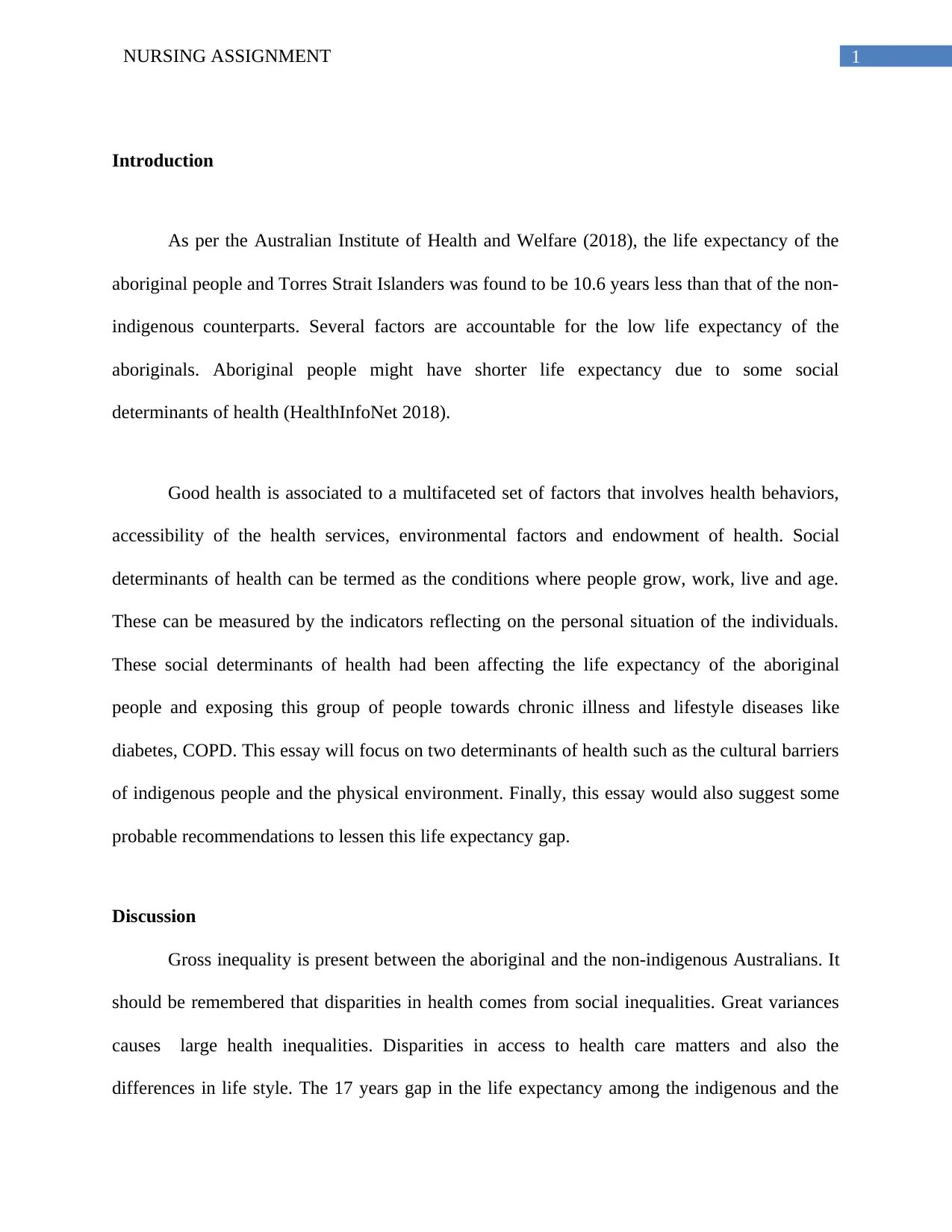
1NURSING ASSIGNMENT
Introduction
As per the Australian Institute of Health and Welfare (2018), the life expectancy of the
aboriginal people and Torres Strait Islanders was found to be 10.6 years less than that of the non-
indigenous counterparts. Several factors are accountable for the low life expectancy of the
aboriginals. Aboriginal people might have shorter life expectancy due to some social
determinants of health (HealthInfoNet 2018).
Good health is associated to a multifaceted set of factors that involves health behaviors,
accessibility of the health services, environmental factors and endowment of health. Social
determinants of health can be termed as the conditions where people grow, work, live and age.
These can be measured by the indicators reflecting on the personal situation of the individuals.
These social determinants of health had been affecting the life expectancy of the aboriginal
people and exposing this group of people towards chronic illness and lifestyle diseases like
diabetes, COPD. This essay will focus on two determinants of health such as the cultural barriers
of indigenous people and the physical environment. Finally, this essay would also suggest some
probable recommendations to lessen this life expectancy gap.
Discussion
Gross inequality is present between the aboriginal and the non-indigenous Australians. It
should be remembered that disparities in health comes from social inequalities. Great variances
causes large health inequalities. Disparities in access to health care matters and also the
differences in life style. The 17 years gap in the life expectancy among the indigenous and the
Introduction
As per the Australian Institute of Health and Welfare (2018), the life expectancy of the
aboriginal people and Torres Strait Islanders was found to be 10.6 years less than that of the non-
indigenous counterparts. Several factors are accountable for the low life expectancy of the
aboriginals. Aboriginal people might have shorter life expectancy due to some social
determinants of health (HealthInfoNet 2018).
Good health is associated to a multifaceted set of factors that involves health behaviors,
accessibility of the health services, environmental factors and endowment of health. Social
determinants of health can be termed as the conditions where people grow, work, live and age.
These can be measured by the indicators reflecting on the personal situation of the individuals.
These social determinants of health had been affecting the life expectancy of the aboriginal
people and exposing this group of people towards chronic illness and lifestyle diseases like
diabetes, COPD. This essay will focus on two determinants of health such as the cultural barriers
of indigenous people and the physical environment. Finally, this essay would also suggest some
probable recommendations to lessen this life expectancy gap.
Discussion
Gross inequality is present between the aboriginal and the non-indigenous Australians. It
should be remembered that disparities in health comes from social inequalities. Great variances
causes large health inequalities. Disparities in access to health care matters and also the
differences in life style. The 17 years gap in the life expectancy among the indigenous and the
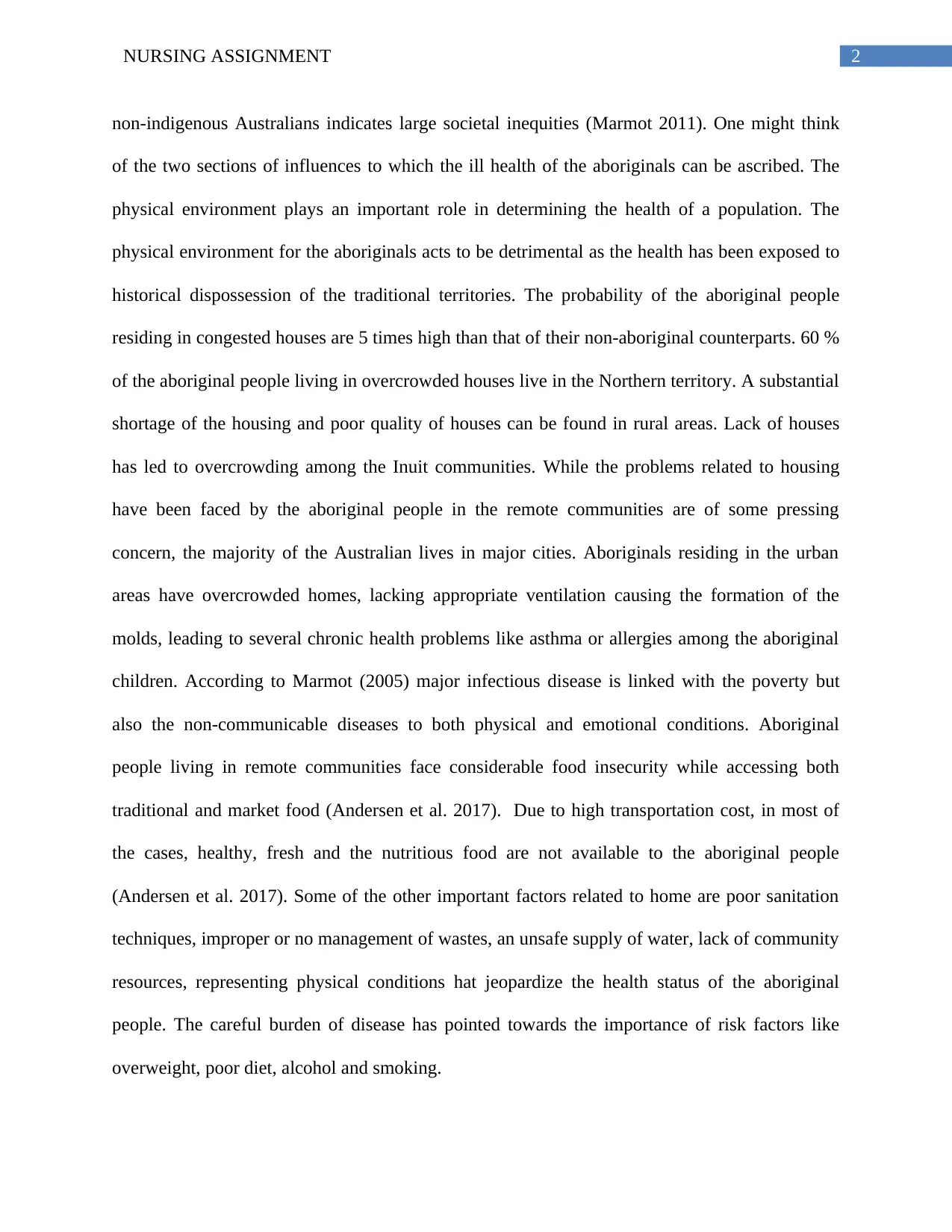
2NURSING ASSIGNMENT
non-indigenous Australians indicates large societal inequities (Marmot 2011). One might think
of the two sections of influences to which the ill health of the aboriginals can be ascribed. The
physical environment plays an important role in determining the health of a population. The
physical environment for the aboriginals acts to be detrimental as the health has been exposed to
historical dispossession of the traditional territories. The probability of the aboriginal people
residing in congested houses are 5 times high than that of their non-aboriginal counterparts. 60 %
of the aboriginal people living in overcrowded houses live in the Northern territory. A substantial
shortage of the housing and poor quality of houses can be found in rural areas. Lack of houses
has led to overcrowding among the Inuit communities. While the problems related to housing
have been faced by the aboriginal people in the remote communities are of some pressing
concern, the majority of the Australian lives in major cities. Aboriginals residing in the urban
areas have overcrowded homes, lacking appropriate ventilation causing the formation of the
molds, leading to several chronic health problems like asthma or allergies among the aboriginal
children. According to Marmot (2005) major infectious disease is linked with the poverty but
also the non-communicable diseases to both physical and emotional conditions. Aboriginal
people living in remote communities face considerable food insecurity while accessing both
traditional and market food (Andersen et al. 2017). Due to high transportation cost, in most of
the cases, healthy, fresh and the nutritious food are not available to the aboriginal people
(Andersen et al. 2017). Some of the other important factors related to home are poor sanitation
techniques, improper or no management of wastes, an unsafe supply of water, lack of community
resources, representing physical conditions hat jeopardize the health status of the aboriginal
people. The careful burden of disease has pointed towards the importance of risk factors like
overweight, poor diet, alcohol and smoking.
non-indigenous Australians indicates large societal inequities (Marmot 2011). One might think
of the two sections of influences to which the ill health of the aboriginals can be ascribed. The
physical environment plays an important role in determining the health of a population. The
physical environment for the aboriginals acts to be detrimental as the health has been exposed to
historical dispossession of the traditional territories. The probability of the aboriginal people
residing in congested houses are 5 times high than that of their non-aboriginal counterparts. 60 %
of the aboriginal people living in overcrowded houses live in the Northern territory. A substantial
shortage of the housing and poor quality of houses can be found in rural areas. Lack of houses
has led to overcrowding among the Inuit communities. While the problems related to housing
have been faced by the aboriginal people in the remote communities are of some pressing
concern, the majority of the Australian lives in major cities. Aboriginals residing in the urban
areas have overcrowded homes, lacking appropriate ventilation causing the formation of the
molds, leading to several chronic health problems like asthma or allergies among the aboriginal
children. According to Marmot (2005) major infectious disease is linked with the poverty but
also the non-communicable diseases to both physical and emotional conditions. Aboriginal
people living in remote communities face considerable food insecurity while accessing both
traditional and market food (Andersen et al. 2017). Due to high transportation cost, in most of
the cases, healthy, fresh and the nutritious food are not available to the aboriginal people
(Andersen et al. 2017). Some of the other important factors related to home are poor sanitation
techniques, improper or no management of wastes, an unsafe supply of water, lack of community
resources, representing physical conditions hat jeopardize the health status of the aboriginal
people. The careful burden of disease has pointed towards the importance of risk factors like
overweight, poor diet, alcohol and smoking.
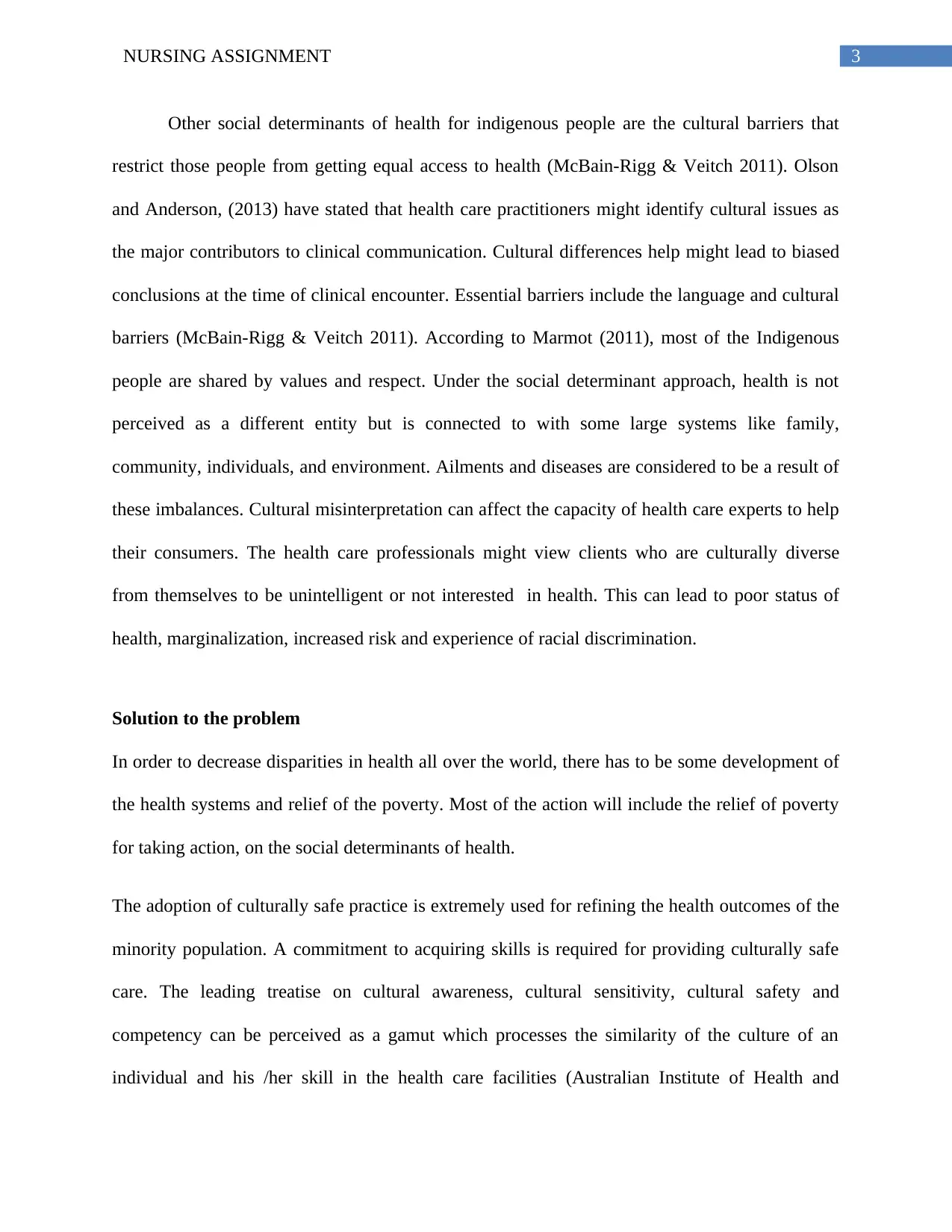
3NURSING ASSIGNMENT
Other social determinants of health for indigenous people are the cultural barriers that
restrict those people from getting equal access to health (McBain‐Rigg & Veitch 2011). Olson
and Anderson, (2013) have stated that health care practitioners might identify cultural issues as
the major contributors to clinical communication. Cultural differences help might lead to biased
conclusions at the time of clinical encounter. Essential barriers include the language and cultural
barriers (McBain‐Rigg & Veitch 2011). According to Marmot (2011), most of the Indigenous
people are shared by values and respect. Under the social determinant approach, health is not
perceived as a different entity but is connected to with some large systems like family,
community, individuals, and environment. Ailments and diseases are considered to be a result of
these imbalances. Cultural misinterpretation can affect the capacity of health care experts to help
their consumers. The health care professionals might view clients who are culturally diverse
from themselves to be unintelligent or not interested in health. This can lead to poor status of
health, marginalization, increased risk and experience of racial discrimination.
Solution to the problem
In order to decrease disparities in health all over the world, there has to be some development of
the health systems and relief of the poverty. Most of the action will include the relief of poverty
for taking action, on the social determinants of health.
The adoption of culturally safe practice is extremely used for refining the health outcomes of the
minority population. A commitment to acquiring skills is required for providing culturally safe
care. The leading treatise on cultural awareness, cultural sensitivity, cultural safety and
competency can be perceived as a gamut which processes the similarity of the culture of an
individual and his /her skill in the health care facilities (Australian Institute of Health and
Other social determinants of health for indigenous people are the cultural barriers that
restrict those people from getting equal access to health (McBain‐Rigg & Veitch 2011). Olson
and Anderson, (2013) have stated that health care practitioners might identify cultural issues as
the major contributors to clinical communication. Cultural differences help might lead to biased
conclusions at the time of clinical encounter. Essential barriers include the language and cultural
barriers (McBain‐Rigg & Veitch 2011). According to Marmot (2011), most of the Indigenous
people are shared by values and respect. Under the social determinant approach, health is not
perceived as a different entity but is connected to with some large systems like family,
community, individuals, and environment. Ailments and diseases are considered to be a result of
these imbalances. Cultural misinterpretation can affect the capacity of health care experts to help
their consumers. The health care professionals might view clients who are culturally diverse
from themselves to be unintelligent or not interested in health. This can lead to poor status of
health, marginalization, increased risk and experience of racial discrimination.
Solution to the problem
In order to decrease disparities in health all over the world, there has to be some development of
the health systems and relief of the poverty. Most of the action will include the relief of poverty
for taking action, on the social determinants of health.
The adoption of culturally safe practice is extremely used for refining the health outcomes of the
minority population. A commitment to acquiring skills is required for providing culturally safe
care. The leading treatise on cultural awareness, cultural sensitivity, cultural safety and
competency can be perceived as a gamut which processes the similarity of the culture of an
individual and his /her skill in the health care facilities (Australian Institute of Health and
Secure Best Marks with AI Grader
Need help grading? Try our AI Grader for instant feedback on your assignments.
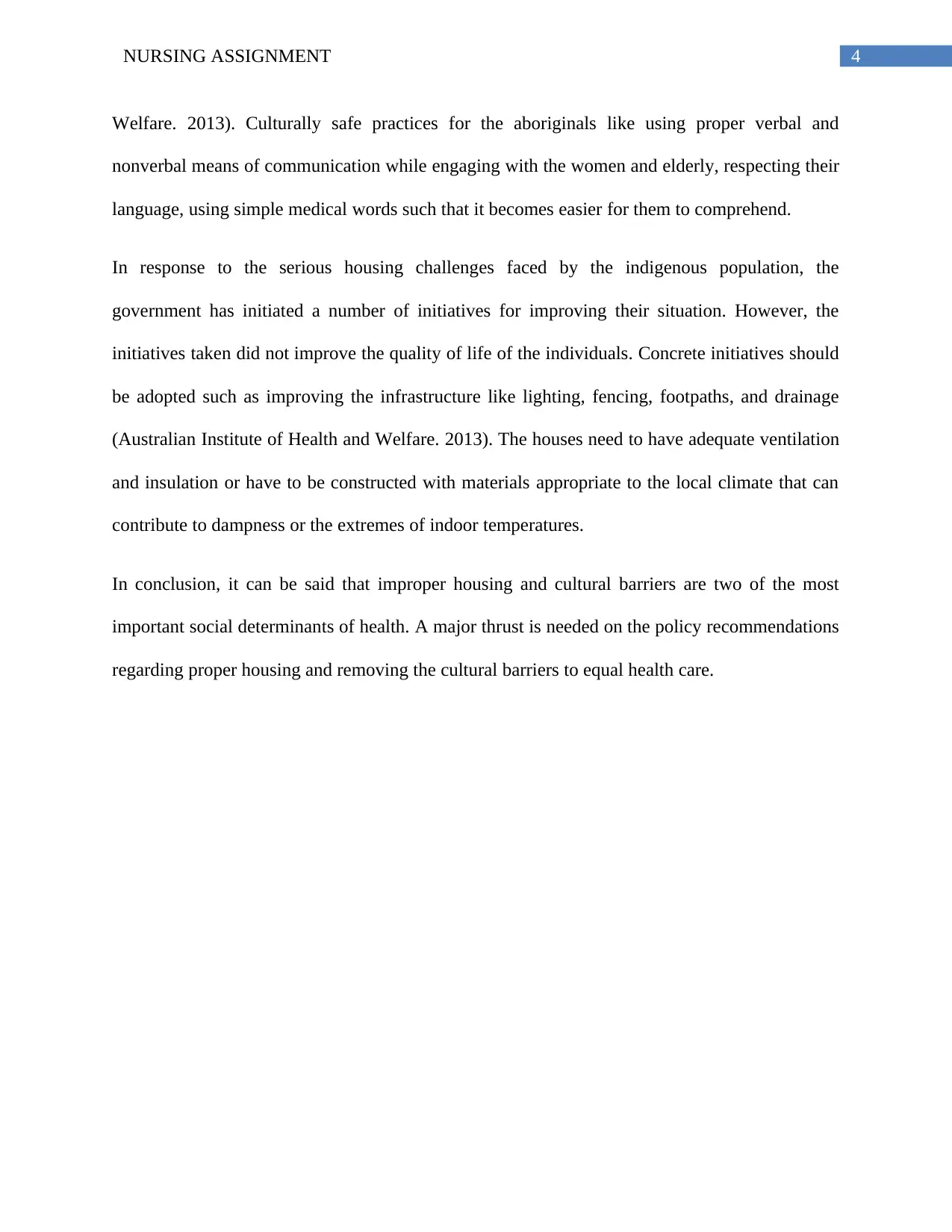
4NURSING ASSIGNMENT
Welfare. 2013). Culturally safe practices for the aboriginals like using proper verbal and
nonverbal means of communication while engaging with the women and elderly, respecting their
language, using simple medical words such that it becomes easier for them to comprehend.
In response to the serious housing challenges faced by the indigenous population, the
government has initiated a number of initiatives for improving their situation. However, the
initiatives taken did not improve the quality of life of the individuals. Concrete initiatives should
be adopted such as improving the infrastructure like lighting, fencing, footpaths, and drainage
(Australian Institute of Health and Welfare. 2013). The houses need to have adequate ventilation
and insulation or have to be constructed with materials appropriate to the local climate that can
contribute to dampness or the extremes of indoor temperatures.
In conclusion, it can be said that improper housing and cultural barriers are two of the most
important social determinants of health. A major thrust is needed on the policy recommendations
regarding proper housing and removing the cultural barriers to equal health care.
Welfare. 2013). Culturally safe practices for the aboriginals like using proper verbal and
nonverbal means of communication while engaging with the women and elderly, respecting their
language, using simple medical words such that it becomes easier for them to comprehend.
In response to the serious housing challenges faced by the indigenous population, the
government has initiated a number of initiatives for improving their situation. However, the
initiatives taken did not improve the quality of life of the individuals. Concrete initiatives should
be adopted such as improving the infrastructure like lighting, fencing, footpaths, and drainage
(Australian Institute of Health and Welfare. 2013). The houses need to have adequate ventilation
and insulation or have to be constructed with materials appropriate to the local climate that can
contribute to dampness or the extremes of indoor temperatures.
In conclusion, it can be said that improper housing and cultural barriers are two of the most
important social determinants of health. A major thrust is needed on the policy recommendations
regarding proper housing and removing the cultural barriers to equal health care.
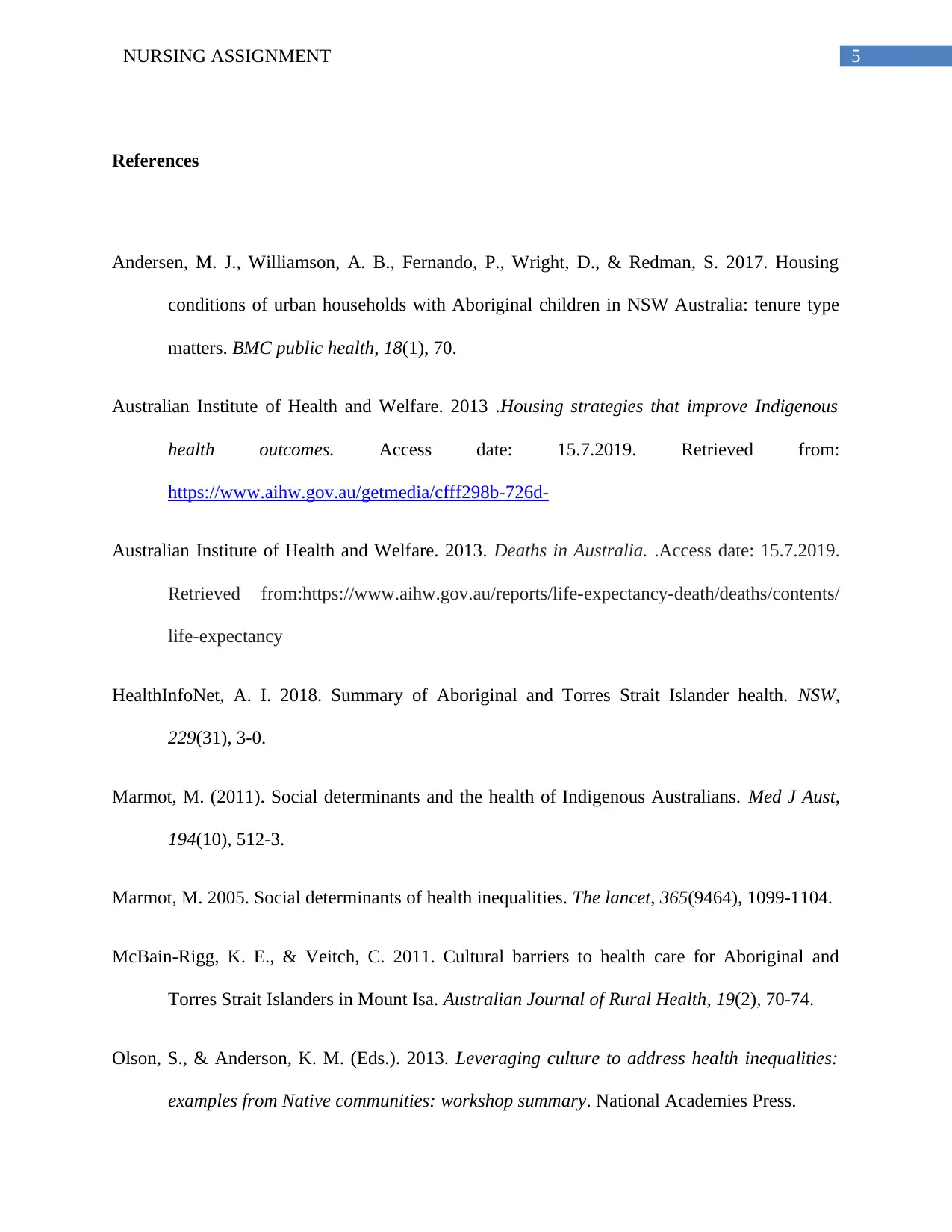
5NURSING ASSIGNMENT
References
Andersen, M. J., Williamson, A. B., Fernando, P., Wright, D., & Redman, S. 2017. Housing
conditions of urban households with Aboriginal children in NSW Australia: tenure type
matters. BMC public health, 18(1), 70.
Australian Institute of Health and Welfare. 2013 .Housing strategies that improve Indigenous
health outcomes. Access date: 15.7.2019. Retrieved from:
https://www.aihw.gov.au/getmedia/cfff298b-726d-
Australian Institute of Health and Welfare. 2013. Deaths in Australia. .Access date: 15.7.2019.
Retrieved from:https://www.aihw.gov.au/reports/life-expectancy-death/deaths/contents/
life-expectancy
HealthInfoNet, A. I. 2018. Summary of Aboriginal and Torres Strait Islander health. NSW,
229(31), 3-0.
Marmot, M. (2011). Social determinants and the health of Indigenous Australians. Med J Aust,
194(10), 512-3.
Marmot, M. 2005. Social determinants of health inequalities. The lancet, 365(9464), 1099-1104.
McBain‐Rigg, K. E., & Veitch, C. 2011. Cultural barriers to health care for Aboriginal and
Torres Strait Islanders in Mount Isa. Australian Journal of Rural Health, 19(2), 70-74.
Olson, S., & Anderson, K. M. (Eds.). 2013. Leveraging culture to address health inequalities:
examples from Native communities: workshop summary. National Academies Press.
References
Andersen, M. J., Williamson, A. B., Fernando, P., Wright, D., & Redman, S. 2017. Housing
conditions of urban households with Aboriginal children in NSW Australia: tenure type
matters. BMC public health, 18(1), 70.
Australian Institute of Health and Welfare. 2013 .Housing strategies that improve Indigenous
health outcomes. Access date: 15.7.2019. Retrieved from:
https://www.aihw.gov.au/getmedia/cfff298b-726d-
Australian Institute of Health and Welfare. 2013. Deaths in Australia. .Access date: 15.7.2019.
Retrieved from:https://www.aihw.gov.au/reports/life-expectancy-death/deaths/contents/
life-expectancy
HealthInfoNet, A. I. 2018. Summary of Aboriginal and Torres Strait Islander health. NSW,
229(31), 3-0.
Marmot, M. (2011). Social determinants and the health of Indigenous Australians. Med J Aust,
194(10), 512-3.
Marmot, M. 2005. Social determinants of health inequalities. The lancet, 365(9464), 1099-1104.
McBain‐Rigg, K. E., & Veitch, C. 2011. Cultural barriers to health care for Aboriginal and
Torres Strait Islanders in Mount Isa. Australian Journal of Rural Health, 19(2), 70-74.
Olson, S., & Anderson, K. M. (Eds.). 2013. Leveraging culture to address health inequalities:
examples from Native communities: workshop summary. National Academies Press.
1 out of 6
Related Documents
Your All-in-One AI-Powered Toolkit for Academic Success.
+13062052269
info@desklib.com
Available 24*7 on WhatsApp / Email
![[object Object]](/_next/static/media/star-bottom.7253800d.svg)
Unlock your academic potential
© 2024 | Zucol Services PVT LTD | All rights reserved.





